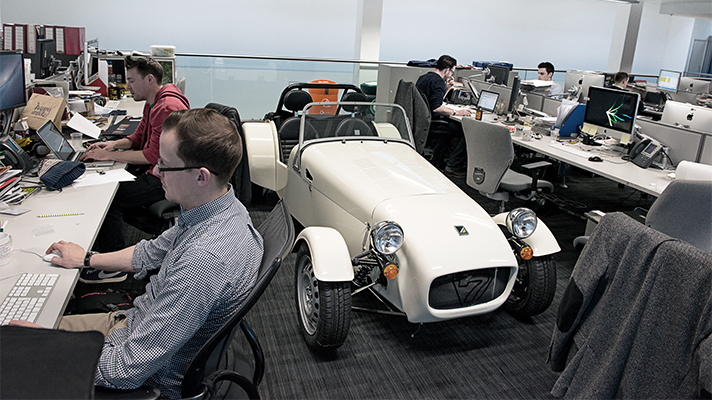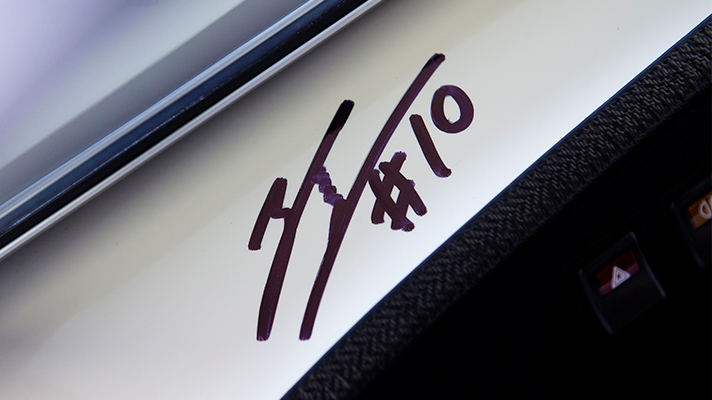
Top Gear builds a Caterham 160
Considering the Caterham Seven 160 is so very small and simple, the number of bits from which it’s made comes as something of a surprise. Especially when those pieces arrive on the back of a lorry in several dozen large cardboard boxes.
The plan, if you could call it that, was to build the new back-to-basics, lightweight sports car with our own fair hands. Why? Because half of all Caterhams sold in Britain are home-built, and three-quarters of all 160s – the cheapest, simplest Seven – will be built by their owners in a shed. But TopGear doesn’t have a shed (not after an unfortunate blowtorch incident a while back). We do, however, have an office…
The Caterham 160 is as simple as things get this side of a pedal car. Its basic design is over 50 years old, it boasts half shafts, live axle suspension and a 660cc, three-cylinder engine from Suzuki. In short, it’s the first DIY car in a long time to fall within the mechanical capabilities of the TG staff. That, and we thought it might make a fun way to spend a few lunch hours.
The Top Gear office, by virtue of being on the second floor, is accessed by many flights of stairs. The lorry carrying our bitty Caterham would not fit up these stairs. So an army – or at least a willing platoon – of TG staffers were dispatched to ferry the smaller boxes (axles, lights, roll bars and seats), but unfortunately the Seven’s three-metre long, 100kg chassis couldn’t be force-fed up the tight staircase.
A quick look at ancient BBC blueprints showed a forgotten service lift, so we wheeled the Caterham’s skeleton up through the office on what looked like a recycled hospital bed, squeaking past many important BBC people doing many important BBC things. Installation complete, and with a minor oil leak covered up by some A4 printer paper, it was time to spanner up.
It’s claimed that, armed with just a simple set of tools and 70 hours of free time, even the most mechanically deficient human should be able to transform Caterham’s pile of boxes into a road-legal car. To make sure there’s no room for artistic interpretation, all kits come fully wired, with the instruments in place, the fuel and brake lines fitted and all essential safety equipment secured. Essentially, all the other parts are just bolt-ons. It’s like an Ikea flat-pack with an exhaust.
The main problem was the instruction manual, which is as thick as a Bible. It’s as old as the Seven – which in turn is as old as the Bible – and bizarrely laid out, with indistinguishable diagrams, usually on the wrong page. After much squinting and a bit of swearing, Ollie Marriage – TG’s motoring editor and the nearest thing we have to a human with any mechanical talent – got cracking on the steering rack.
When doing so, he discovered a few more issues. Once you’ve cracked the manual, you must locate the parts. Most builders will arrange their unbuilt car like an Airfix model, so the bits are as organised as James May’s spice rack. This is vital, because most parts aren’t labelled, or particularly well organised, and sometimes they’re not even in the right box at all. Still, after a lot of rummaging, followed by some light bleeding, we had a steering rack. This was satisfying. A thing! That we’d created!
The problem with using desks as workbenches is that nuts and washers are frequently lost behind old coffee cups. No matter. In honour of the Seven’s creator, Colin Chapman, we’d use his old saying: “Simplify, then add lightness.” So where two spacers or washers were needed, we’d use one. And in honour of that other engineering giant, Jeremy Clarkson, we’d often hit things with a hammer. Besides, the wishbones would never have come together without some gentle massaging with TG’s sturdiest mallet.
It wasn’t just Ollie getting oily. His kids helped too. Editor Turner also enlisted his offspring along with brother Turner – a former Caterham owner who knows how to put these things together. So in went the anti-roll bar, rather expertly, we should add. Soon we’d attached the lights, sorted the front and rear suspension, fitted the half shafts and installed the diff. All four wheels were attached and the interior was complete. We had built what looked like a car. Unfortunately, as we made for the pub, several boxes remained unopened, one of which contained the engine. In another was the gearbox. And with a shakedown test approaching, we decided it was time to call in some help.
Top Gear
Newsletter
Thank you for subscribing to our newsletter. Look out for your regular round-up of news, reviews and offers in your inbox.
Get all the latest news, reviews and exclusives, direct to your inbox.
Handily, Caterham has a Formula One team, and its factory is a mere 66 miles from the Top Gear office. And because they don’t have anything better to do a month before the Australian Grand Prix, they agreed to dispatch some men to transport the whole car to Leafield in Oxfordshire, where they’d add some finishing touches. In a bay usually reserved for F1 cars, they finished knocking up the 160 in time for their flight Down Under.
All we needed now was a driver. Thankfully, Caterham has a new work experience lad who was keen to get his first taste of his new team’s product…
So here I am at Silverstone, walking around our white 160 with Kamui Kobayashi – the incredibly friendly and disturbingly animated Japanese F1 star. It turns out Caterham’s new boy has yet to actually drive a Caterham. And, unlike other F1 drivers with their exotic supercar collections, Kamui doesn’t even own a car. Moreover, he’s not especially keen on driving on the road. “There’s no excitement in driving road cars,” he says. “The only exciting part is having a nice-looking girl next to me.” But if there’s one car that should change his mind, it’s our incredibly slow, incredibly basic Seven. Right?
“You built this?!” he asks. I nod. It would seem word of TG’s mechanical prowess has reached Japan. He reaches into his pocket and grabs his phone. “Let me just call my insurance company,” he says. I tell him it has about 80bhp, and at least some torque. “Ok,” he says, “so if the wheel does fall off, I won’t be going that fast.” Good point. On this note, he slips into his racing overalls and attempts to remove the Caterham’s steering wheel. I inform him that, unlike his F1 car, it doesn’t come off. Or, at least, it shouldn’t. Once inside, he slides the leather seat all the way forward, fires the little engine, gives it a rev and smiles as the turbo whooshes.
As he exits the garage the 160 pops and parps its way down the pit lane. He stomps on the accelerator, then the brakes, while weaving around, flashing the comedy headlights and tooting the horn. Then he yanks on the handbrake, U-turns and powers the wrong way down the pit lane, which today is being used by several other cars. Just 90 seconds into its motoring life, our car narrowly avoids an incoming Ginetta. Unfazed, Kamui skitters past, hopping around in his seat, shouting: “Fun car! Fun car!”
The marshals don’t share his enthusiasm. His antics have earned a stern warning, but after a quick apology, he’s giving our home-brew Caterham a proper workout. Through Maggots and Becketts, the writing on the sidewalls of the skinny rear tyres becomes the main point of contact with the tarmac.
“I normally need two laps to understand a new car,” Kamui says later. “But with this, I knew in one corner what it was like. You feel that it’s alive, moving under you, but you’re not scared. You’re not going fast enough.”
After a few more laps, he has the throttle pinned pretty much everywhere, while all four tyres cling to the rims for dear life. Down the main straight, he looks back to the pits and pumps the air. As he closes in on Copse corner at the car’s 100mph top speed, my guts churn. What if that rear brake drum comes loose? Would he be doing an exploratory lap of rural Northamptonshire? Let’s hope the Formula One boys had a good set of spanners…
Of course they did. And, after a morning of punishment by one of the world’s most committed F1 drivers, our little 160 has passed its tough first test. Nothing fell off, nothing broke and our testdriver remained fit and healthy. A roaring success, you could say.
Now if only we could figure out where these nuts should go. They’ve been lying around the office for weeks…
Trending this week
- Car Review
BMW iX3









